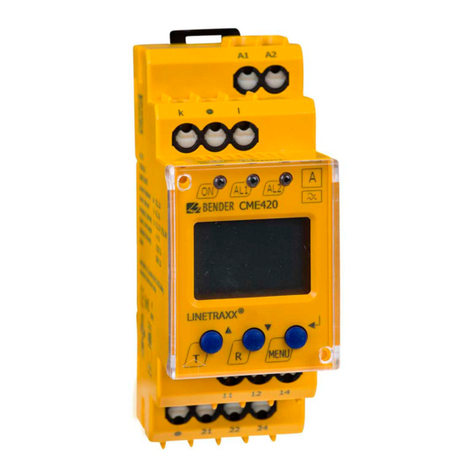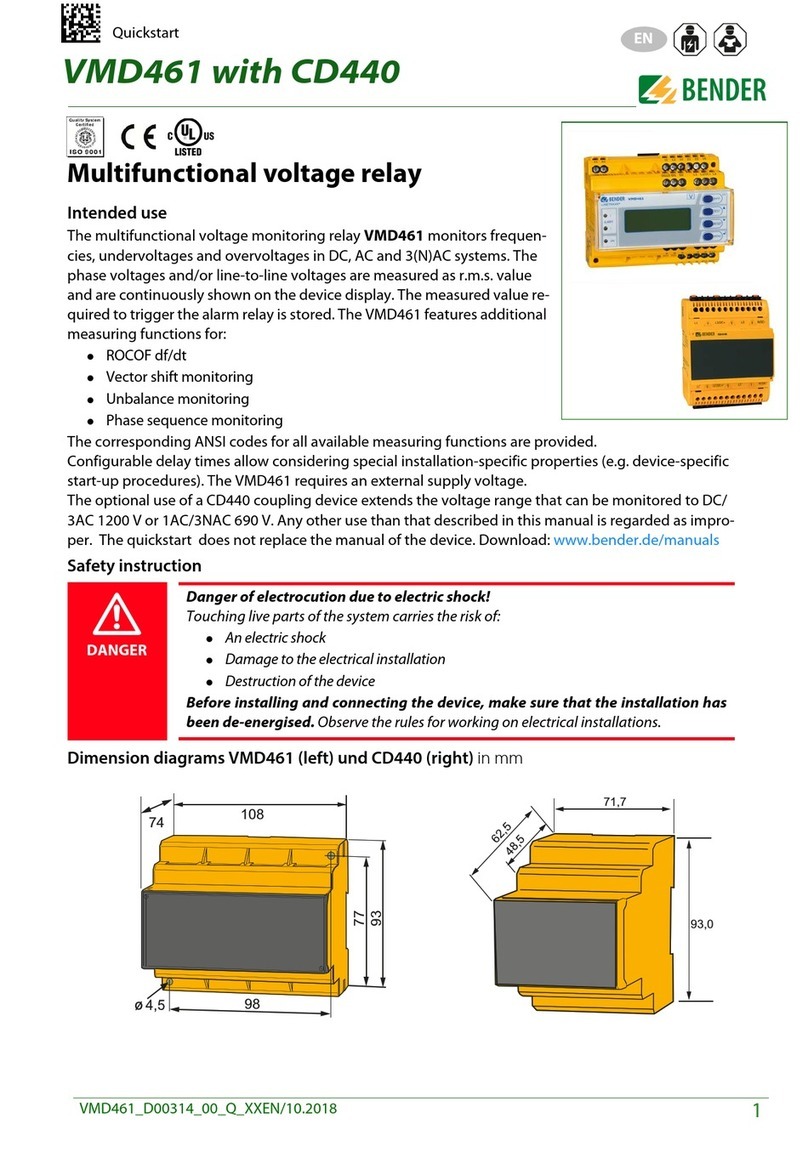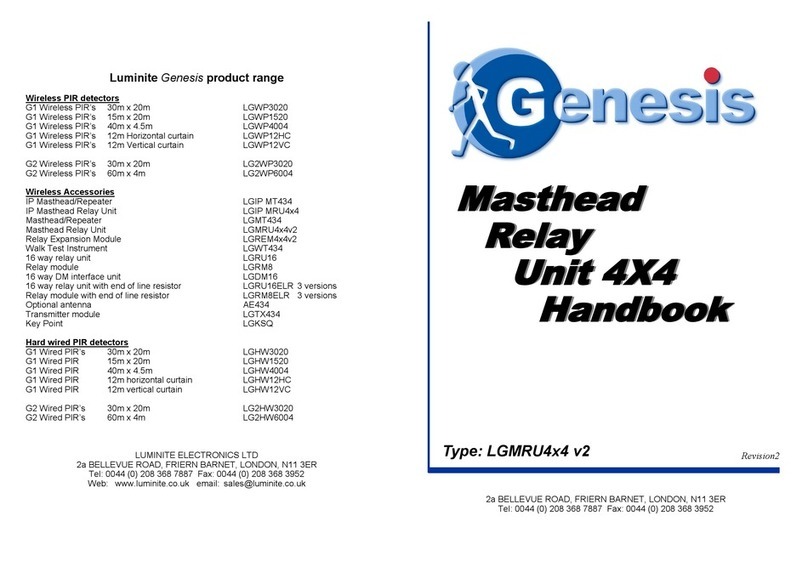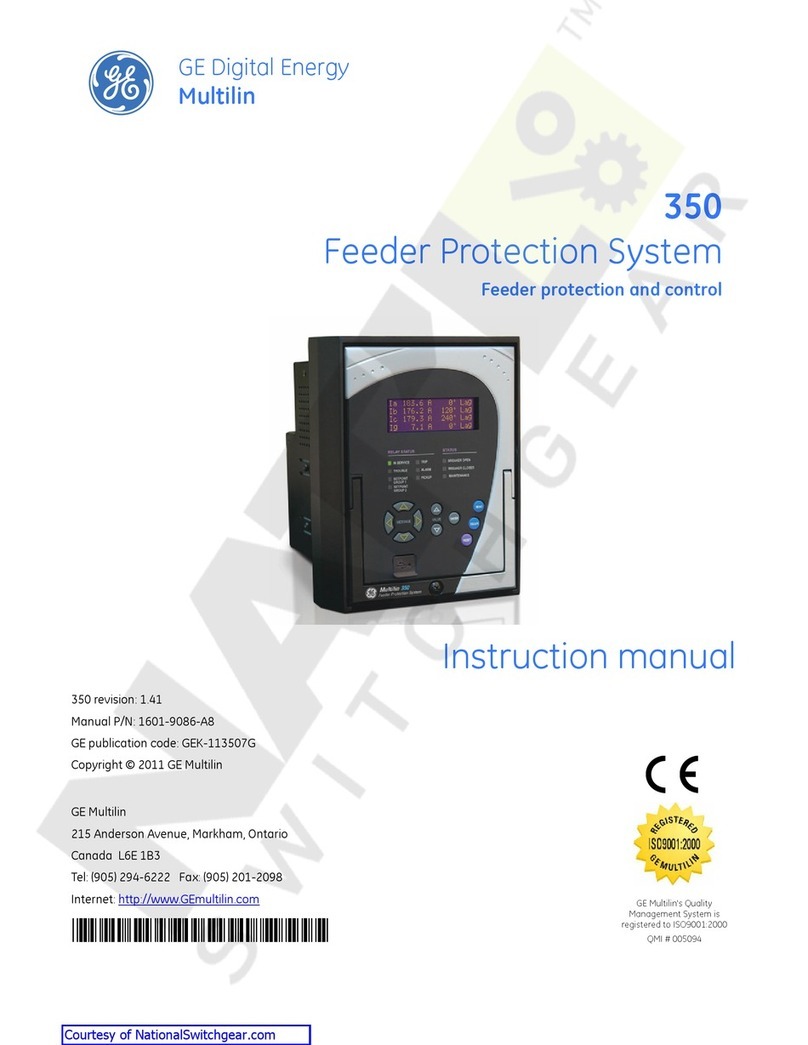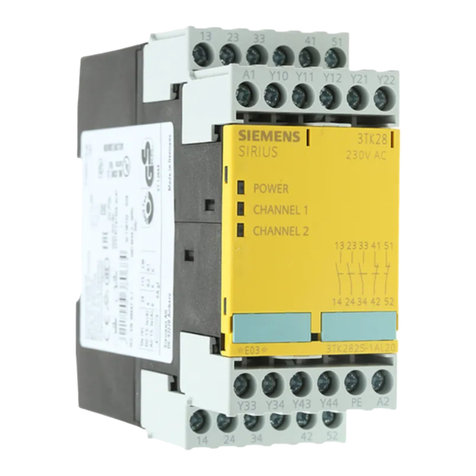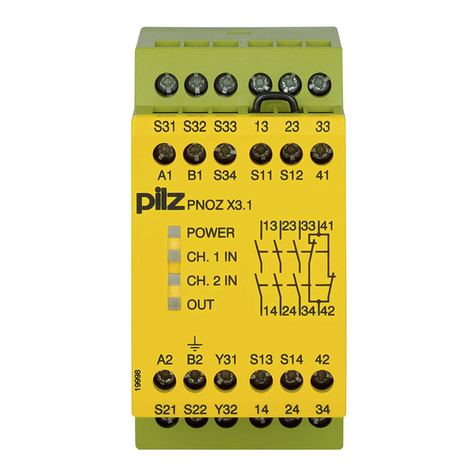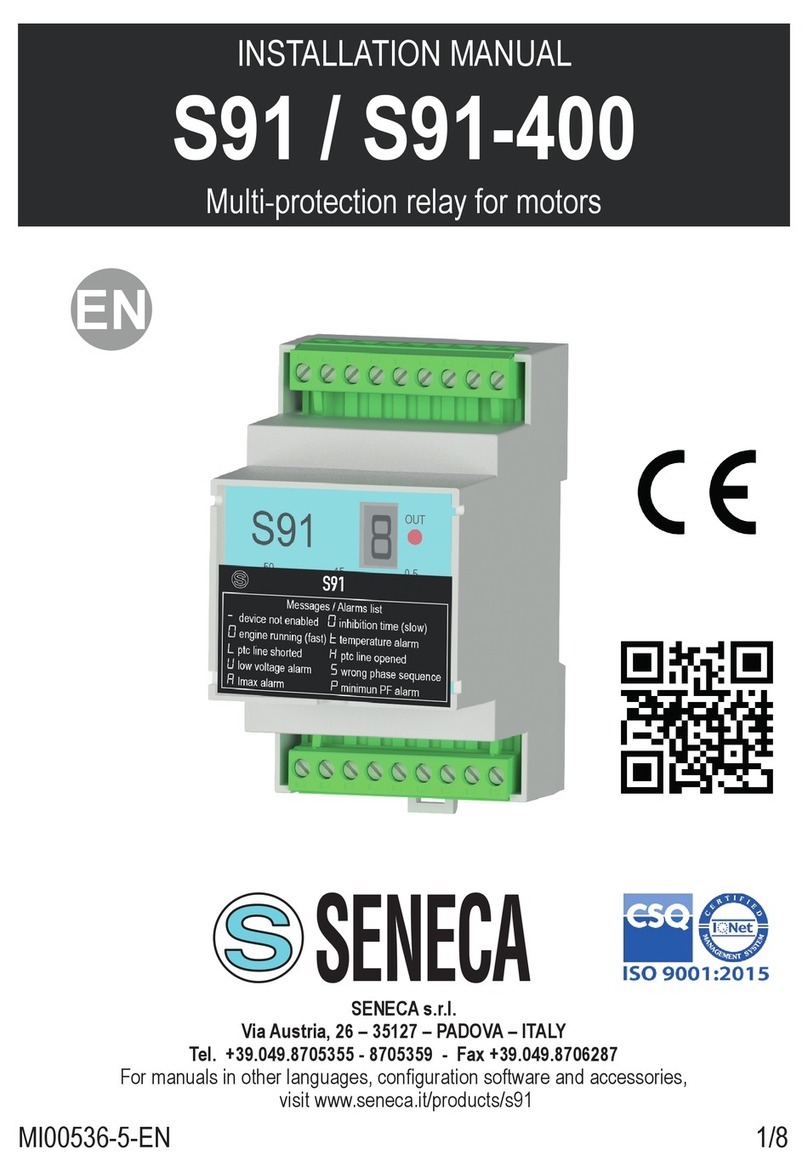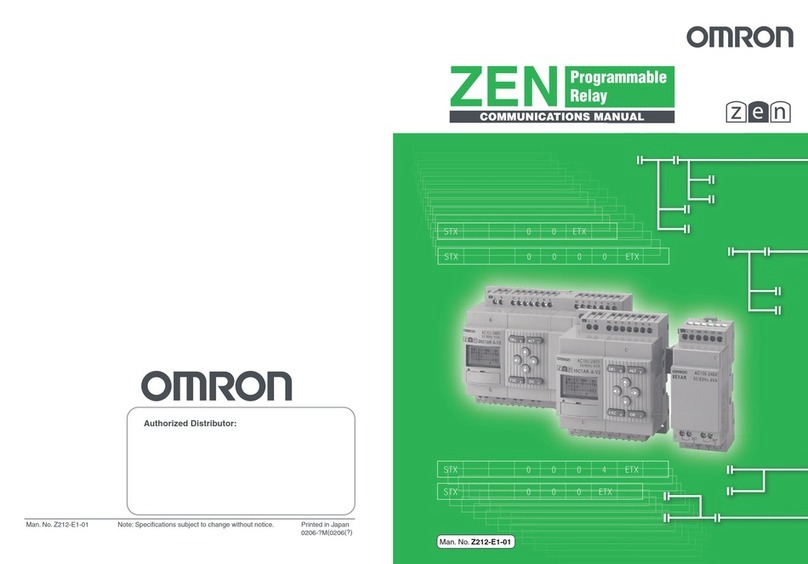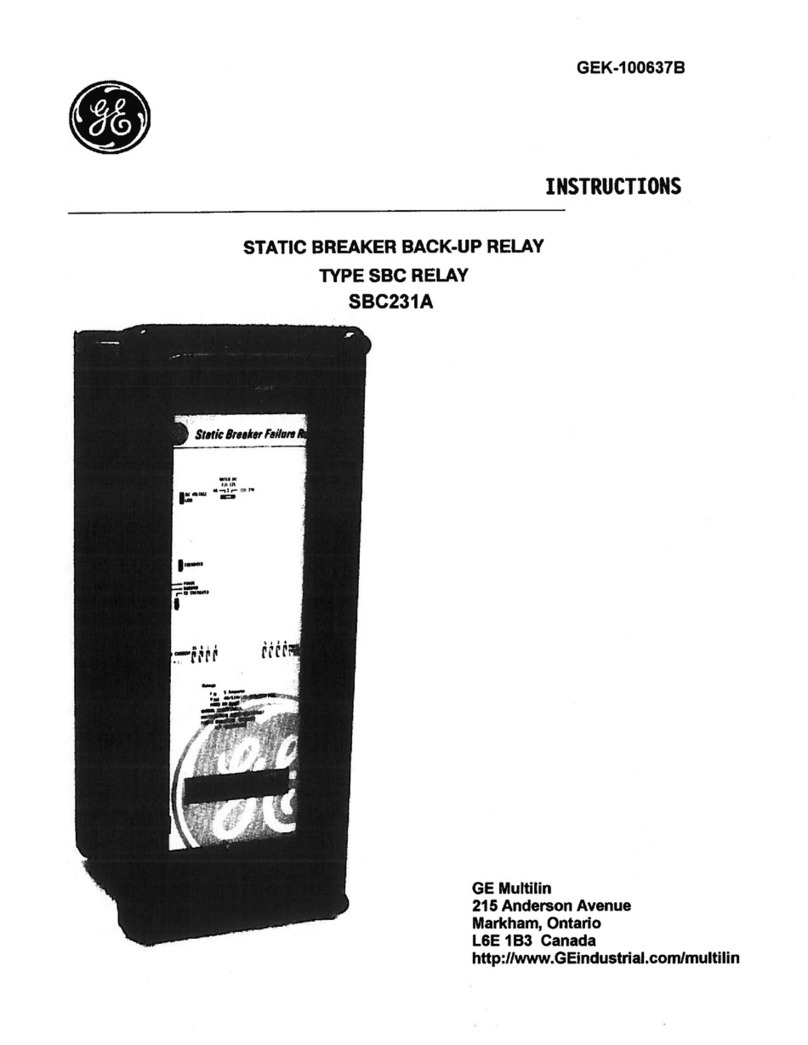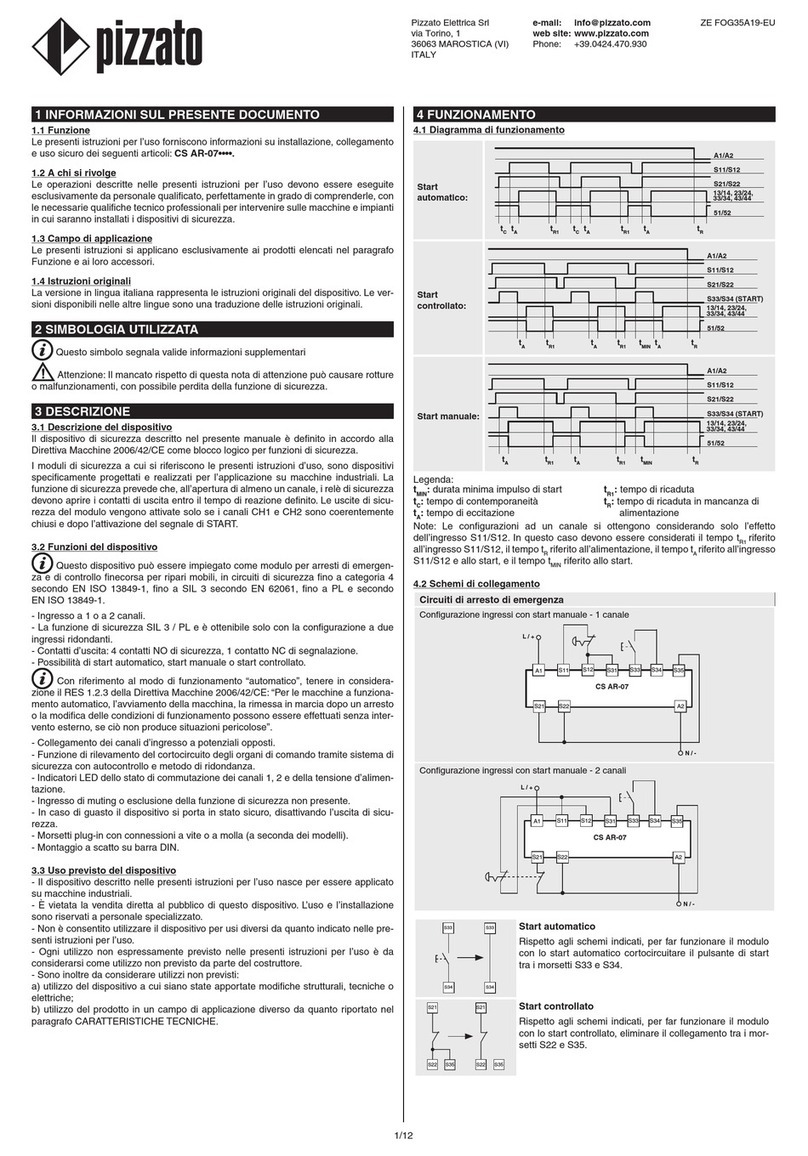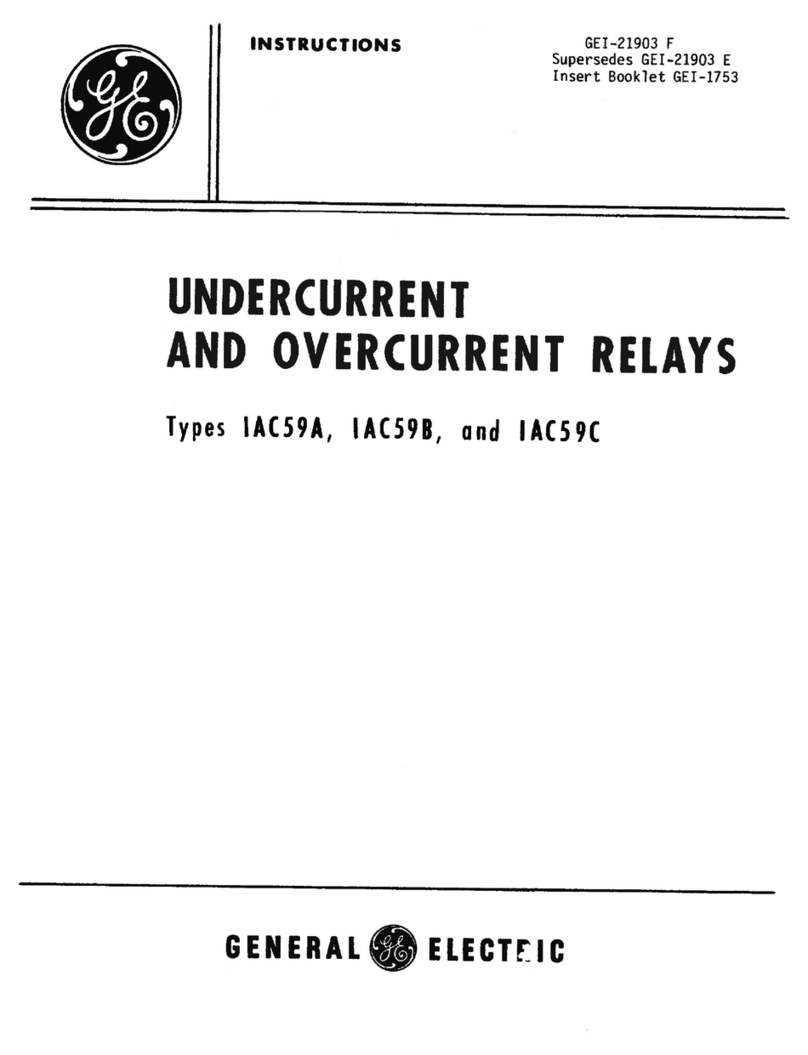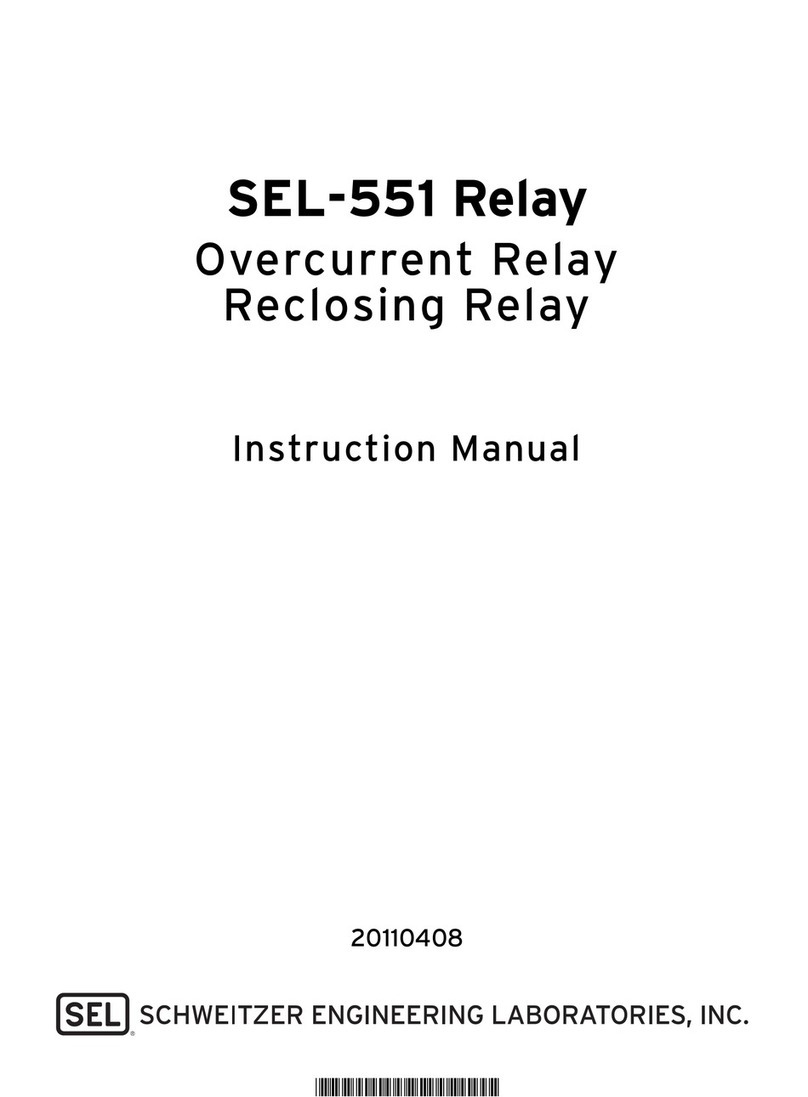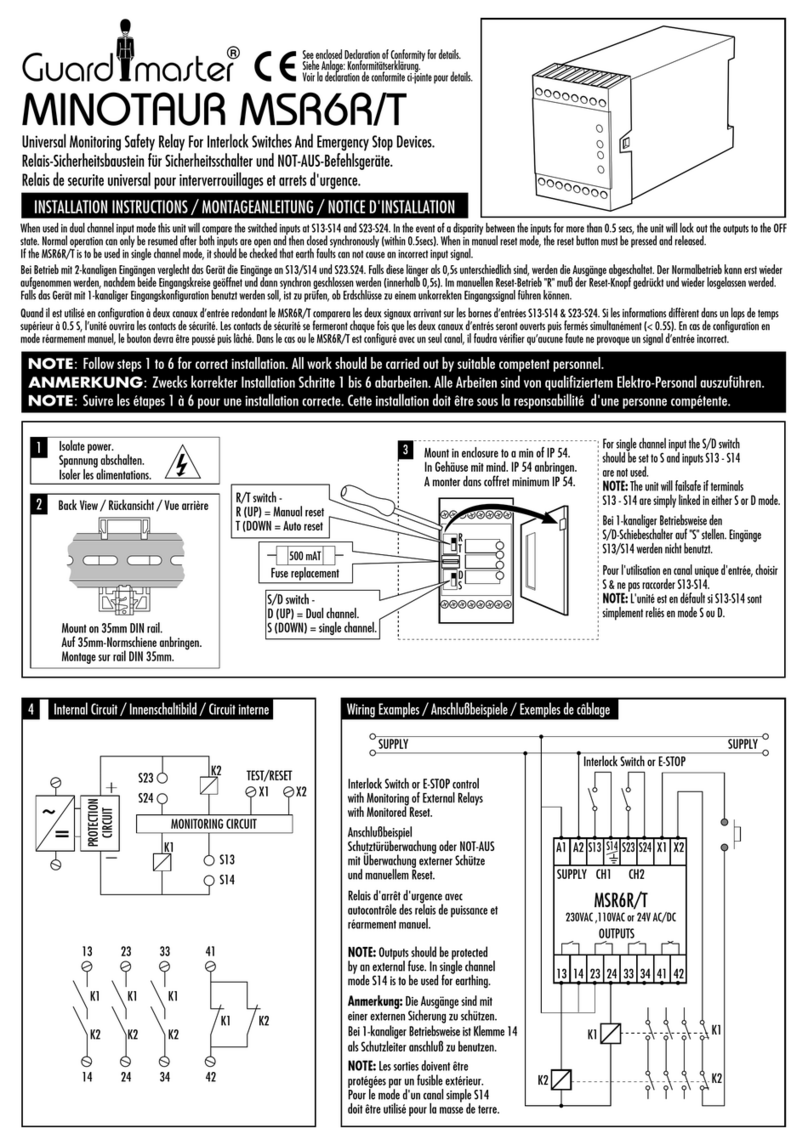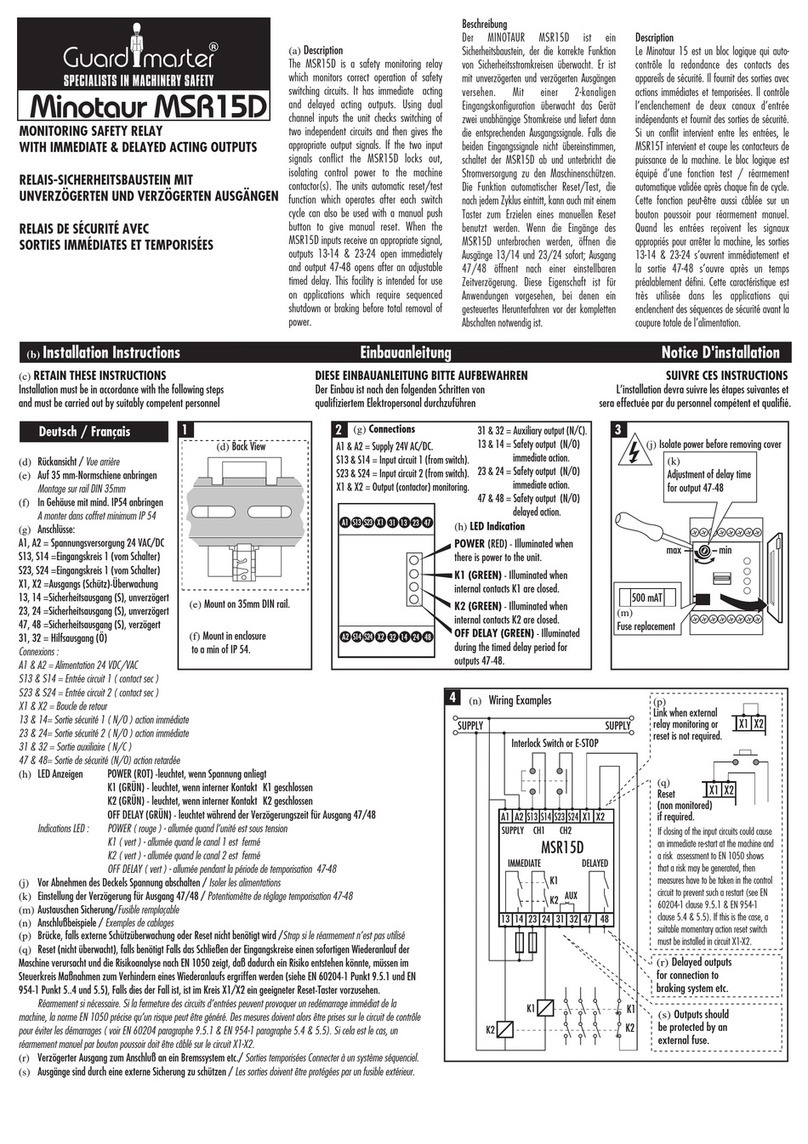Bender CMD420 User manual

T M
Document NAE1038810 • 01.2013 • © Bender Inc. • Page 1/1 • Side 1/2Bender Inc. • USA: 800.356.4266 / 610.383.9200 / info@bender.org • Canada: 800.243.2438 / 905.602.9990 / [email protected] • www.bender.org
US
k1 l1
k2
L2
l2
k3
L3
l3
A1
11 12 14
K1
K2
21 22 24
A2
k1 l1 k2
k3 A1 A2l3
l2
CMD420 / CMD421
Installation Bulletin / Reference Guide
This document is intended as a reference guide for installing and using BENDER CMD420 and CMD421
three-phase AC current relays. This document includes installation, setup, and usage instructions. For
complete details, including installation, setup, settings, and troubleshooting, refer to the CMD420 /
CMD421 user manual, document number TGH1459en. This document is intended as a supplement
and not a replacement to the complete user manual.
Only qualied maintenance personnel shall operate or service this equipment. These instructions
should not be viewed as sucient for those who are not otherwise qualied to operate or service this
equipment. This document is intended to provide accurate information only. No responsibility is as-
sumed by BENDER for any consequences arising from use of this document.
Installation
Mounting
CMD420 / CMD421 series devices may be DIN rail mounted, or screw mounted using the black
clips located on the top and bottom of the device. Screw mounting requires an extra black clip
(article number B98060008, sold separately).
!DANGER
• Disconnect all power before servicing.
• Observe all local, state, and national
codes, standards, and regulations.
HAZARD OF ELECTRIC SHOCK,
EXPLOSION, OR ARC FLASH
Wiring - General
Refer to gure 1 for wiring the CMD420 or CMD421.
When using the CMD420, a current transformer with
1 A secondary (x/1 type) is required. For CMD421 de-
vices, a current transformer with a 5 A secondary (x/5
type) is required. Use minimum AWG 24, maximum
AWG 12 size wire. Refer to CMD420 / 421 series user
manual for complete technical details.
1. External supply voltage; 5A fuse
required for internal device pro-
tection
2. Connection to individual phase
conductors via current transform-
ers. Use x/1 type (1 A secondary)
for CMD420 and x/5 type (5 A sec-
ondary) for CMD421.
3. Alarm relay K1: SPDT contact
4. Alarm relay K2: SPDT contact
Figure 1 - Common wiring diagram for CMD420 and CMD421
Front Panel Display
1. LED “ON” (green): Illuminates when
power is applied to the device. Flashes
when the CT connection alarm is active.
2. LED “AL1” (yellow): Illuminates when
the prealarm is activated. Flashes when
the CT connection alarm is active.
3. LED “AL2” (yellow): Illuminates when
the main alarm is activated. Flashes
when the CT connection alarm is active.
4. Backlit LCD display
5. TEST / UP button: Activates self-test /
scrolls up inside main menu.
6. RESET / DOWN button: Resets device /
scrolls down inside main menu.
7. MENU / ENTER button: Activates main
menu / Confirms (momuntary push) or
goes back a step (held > 1.5 s) inside
main menu.
1 2 3
4
5 6 7
Dimensions
Dimensions listed in inches (mm).
Figure 2 - CMD420 / CMD421 front display
1.42” (36)
2.78”
(70.5)
1.87”
(47.5)
1.22” (31.1)
2.66” (67.5)
1.77” (45)
3.54” (90)
1
2
3
Menu Flow Chart for Common Settings
Figure 4 through gure 8 on the reverse side of this document contain ow charts for modify-
ing commonly used features and settings in the device’s main menu. Not all available features
are listed in this document. For more information, consult the CMD420 / CMD421 user manual.
R
T
Menu Legend
MENU / ENTER button
DOWN ARROW button
UP ARROW button
Momuntary button push
< 1.5 s
Hold button for at least 1.5 s,
then release
> 1.5 s
Normally energized mode (N/E)
Failsafe mode
“N/C”in device settings menu
Power ON, normal state (no alarms)
Power OFF
Power ON, alarm state
11-12 OPEN
11-14 CLOSED
11-12 CLOSED
11-14 OPEN
11-12 CLOSED
11-14 OPEN
21-22 OPEN
21-24 CLOSED
21-22 CLOSED
21-24 OPEN
21-22 CLOSED
21-24 OPEN
Normally deenergized mode (N/D)
Non-failsafe mode
“N/O”in device settings menu
Power ON, normal state (no alarms)
Power OFF
Power ON, alarm state
11-12 CLOSED
11-14 OPEN
11-12 CLOSED
11-14 OPEN
11-12 OPEN
11-14 CLOSED
21-22 CLOSED
21-24 OPEN
21-22 CLOSED
21-24 OPEN
21-22 OPEN
21-24 CLOSED
Relay Operation Setting Device Alarm State K1 STATE K2 STATE
Device Relay Conditions
Wiring - Contacts
Using a normally closed or normally open contact utilizes two factors: wiring out of the proper
terminal, and setting the respective contact to normally energized or deenergized operation.
Refer to the chart below for relay conditions. For changing the energized state of the contact,
refer to “Figure 7 - Contact operation” on the reverse side of this document.
The factory default is normally deenergized operation for relays K1 and K2.
4

T M
Document NAE1038810 • 01.2013 • © Bender Inc. • Page 1/1 • Side 2/2Bender Inc. • USA: 800.356.4266 / 610.383.9200 / info@bender.org • Canada: 800.243.2438 / 905.602.9990 / [email protected] • www.bender.org
CMD420 / CMD421
Installation Bulletin / Reference Guide
Figure 5 - Changing Time Delays
Four separate time delays are available:
• ton1 - Response delay, prewarning
• ton2 - Response delay, main alarm
• t - Startup delay
• toff - Delay on release
= Flashing Symbol
T R
ton1 Adjustment
0...10 seconds
> 1.5 sec
< 1.5 sec
< 1.5 sec
< 1.5 sec
R
Press:
1 x for ton2
2 x for t
0...10 sec
3 x for toff
0...99 sec
OR
R
Press Twice
> 1.5 sec
> 1.5 sec
Figure 6 - Latching behavior (fault memory)
= Flashing Symbol
T R
> 1.5 sec
Press Once
Fault Memory
ON/OFF Select
> 1.5 sec
> 1.5 sec
< 1.5 sec
< 1.5 sec
< 1.5 sec
R
= Flashing Symbol
T R
Failsafe
ON/OFF Select
> 1.5 sec
Press Once
R
Press Once
R
> 1.5 sec
> 1.5 sec
< 1.5 sec
< 1.5 sec
< 1.5 sec
Figure 7 - Contact operation
Use this option to change the behavior of the contacts between normally deenergized (non-
failsafe) mode and normally energized (failsafe) mode. The two SPDT contacts may be changed
individually. Note that the CMD420/CMD421 labels normally deenergized operation as “N/O”
and normally energized operation as “N/C”; utilzing a normally open or normally closed con-
tact only depends on which contact output is wired.
Figure 4 - Setting alarm type and CT ratio
The recommended rst step is to set the type of alarm that will be used. Set this option to “HI”
for undercurrent, “LO” for undercurrent, or “In” for both (window function).
Regardless whether the CMD420 or CMD421 is being used, the ratio of the current transformer
used must be entered into the device as an X/1 type. For example, if using a 50:1 ratio CT with
the CMD420, enter a value of “50” for the CT ratio. If using a 250:5 ratio CT with the CMD421,
enter a value of“50” for the CT ratio.
NOTE: See below for instructions on setting alarm values. Alarm values will still be entered into
the device based on the secondary side (0 - 1 A for the CMD420, 0-5 A for the CMD421). How-
ever, since the CT ratio has been entered into the device, values on the primary side of the CT
will be displayed in real-time on the device’s screen during operation.
= Flashing Symbol
> 1.5 sec
< 1.5 sec
< 1.5 sec
Press nothing for
overcurrent (HI)
otherwise:
R
1x for both (In)
2x for undercurrent (Lo)
T R
Ratio Adjustment
> 1.5 sec
To quit
R
OR
To set CT
ratio
x 2
Rx 3
< 1.5 sec
> 1.5 sec
> 1.5 sec
> 1.5 sec
> 1.5 sec
To quitx 2
Figure 5 - Setting Alarm Values
The CMD420/CMD421 has two alarm values that may be set. Use the following guidelines for
setting these numbers:
• Using only overcurrent OR undercurrent: Only one value is required. The value I2is the
explicit alarm value that is set. The value I1is an optional prewarning that may be acti-
vated, which is a percentage value based on the previously set trip value.
• Using both overcurrent AND undercurrent: Both values are required. The value I2is the
overcurrent value, entered as an explicit number. The value I1is the undercurrent value,
entered as a percentage of the previously entered overcurrent value. EXAMPLE: For an
overcurrent alarm of 2 A and an undercurrent alarm of 1 A, enter“2” for I2, and enter“50%”
for I1.
= Flashing Symbol
> 1.5 sec
T R
Setpoint
Adjustment
R
< 1.5 sec
< 1.5 sec
< 1.5 sec
< 1.5 sec
T R
Setpoint
Adjustment
< 1.5 sec
> 1.5 sec
> 1.5 sec
I 2
A
I 2
A
= Flashing Symbol
> 1.5 sec
T R
Setpoint
Adjustment
R
< 1.5 sec
< 1.5 sec
< 1.5 sec
< 1.5 sec
T R
Setpoint
Adjustment
< 1.5 sec
> 1.5 sec
> 1.5 sec
I 2
A
I 2
A
Changing this setting aects the latching be-
havior of the device:
• “OFF” will cause the device to automati-
cally reset if the alarm condition clears.
• “ON”will cause the device to latch in the
event of an alarm and require a manual
reset. If power is cycled to the device
and the alarm condition has cleared, the
device will reset.
• “CON” will cause the device to latch
in the event of an alarm and require a
manual reset. The device will remain
latched even if power is cycled to the
device.
Other manuals for CMD420
2
This manual suits for next models
1
Other Bender Relay manuals
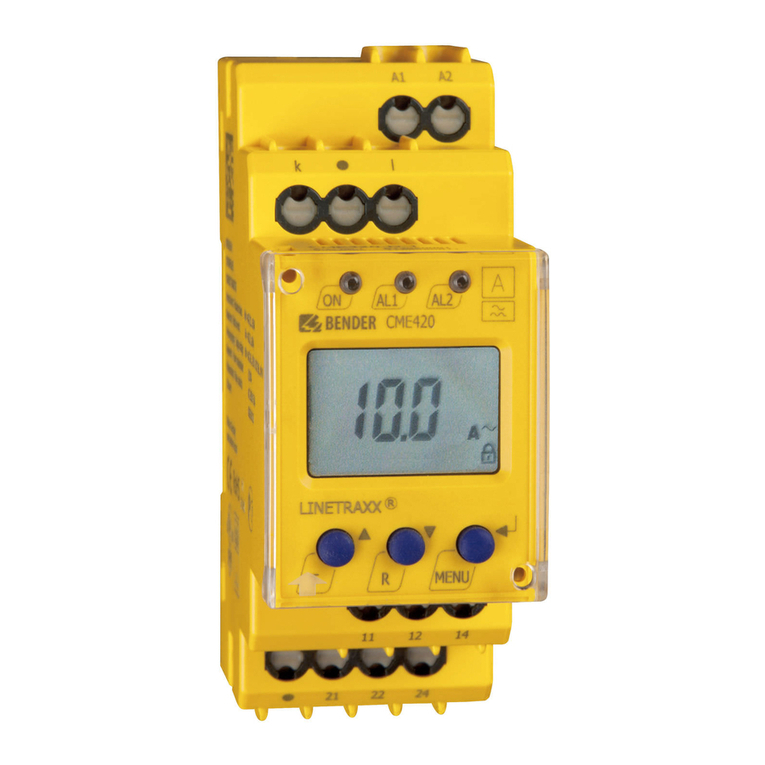
Bender
Bender cme420 User manual
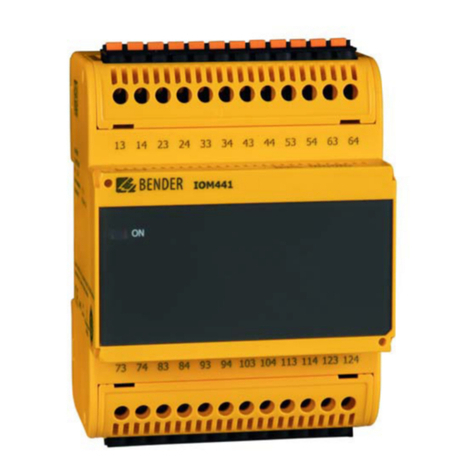
Bender
Bender IOM441-S User manual
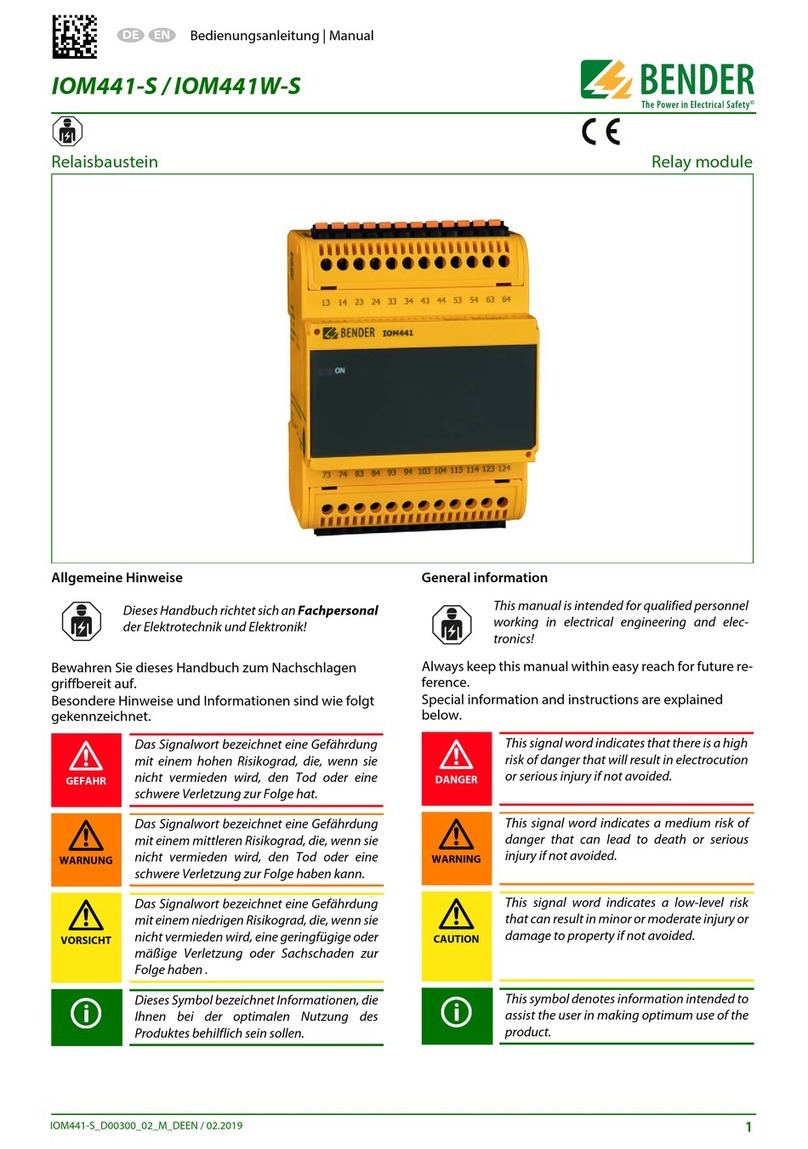
Bender
Bender IOM441-S User manual

Bender
Bender IOM441-S User manual

Bender
Bender cme420 Manual
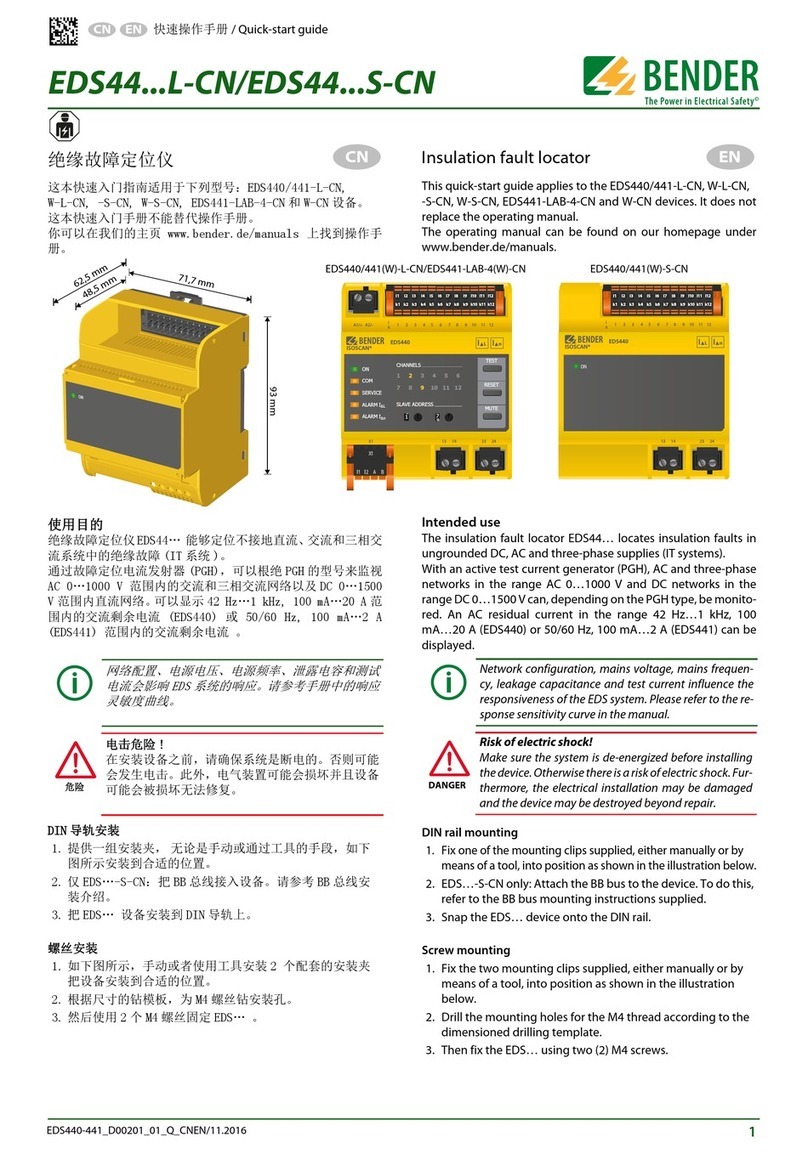
Bender
Bender EDS44 L-CN Series User manual
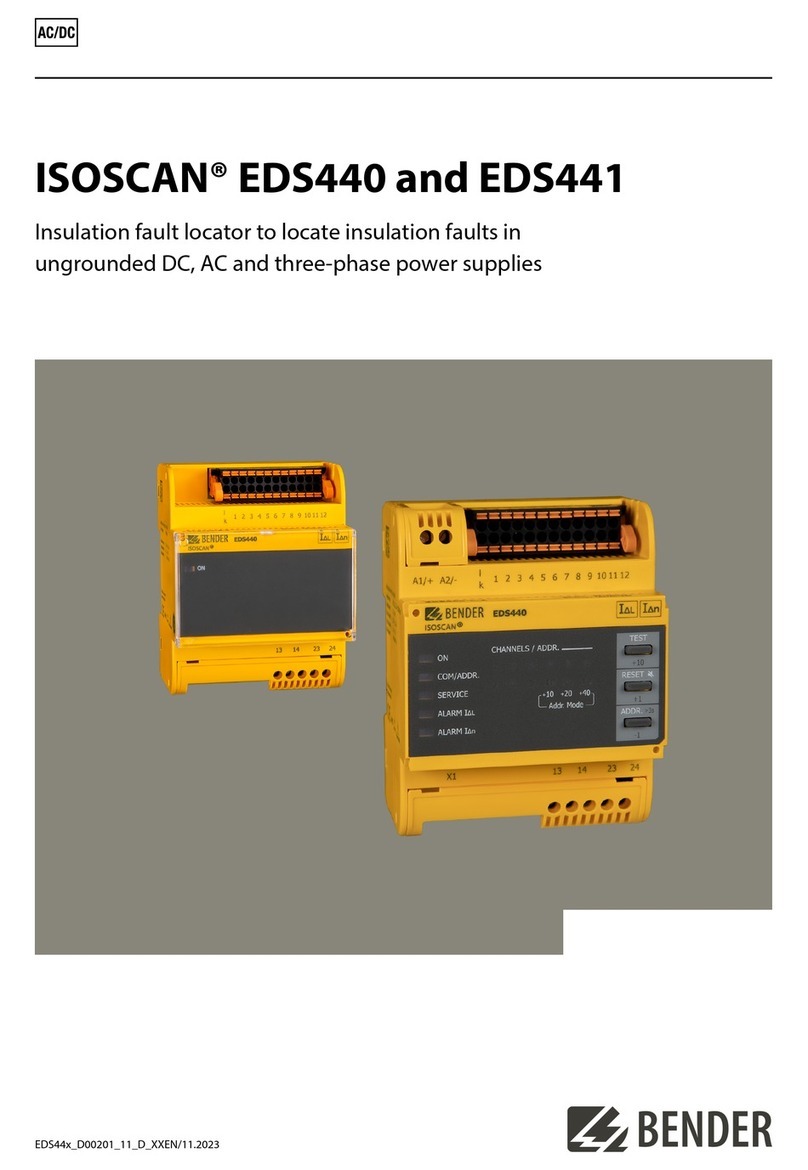
Bender
Bender EDS440 Instruction manual
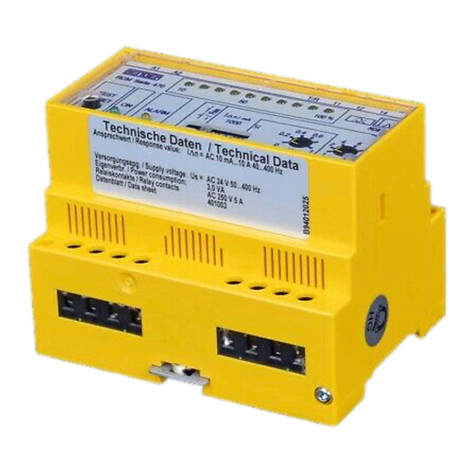
Bender
Bender RCM470LY User manual
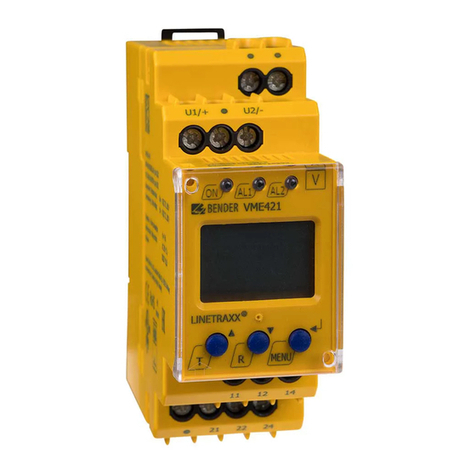
Bender
Bender VME421H User manual

Bender
Bender LINETRAXX VMD258 User manual
